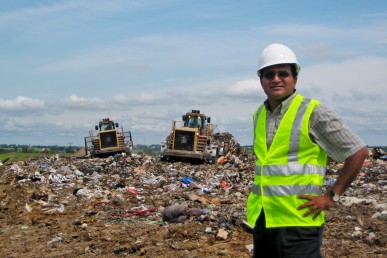Designing landfills that clean themselves
A University of Illinois at Chicago engineering professor is designing state-of-the-art landfills that will really stand out from those that are just — well, dumps.
When a landfill dries out, the waste degrades so slowly it can take decades for the area to stabilize and become safe for other uses, says Krishna Reddy, UIC professor of civil and materials engineering. Such nonperforming landfills, he said, are called “dry tombs.”
Reddy has been awarded a three-year $280,000 grant from the National Science Foundation to develop a model to transform dry-tomb landfills into efficient waste treatment systems.
“Landfills are eyesores,” Reddy said. “But they’re unavoidable. Even with the best waste management — prevention and recycling — we still will have waste that has to be disposed of.
“We don’t want to create these indestructible pyramids, and have future generations look at them and think, ‘what the heck have they done?'” he said.
Reddy and his students want to make landfills that perform their own in-ground treatment, produce gas to recapture energy, allow the recovery of usable materials, and re-stabilize their own site for eventual reuse.
To engineer landfills that can do all this, Reddy must find the best way to capture the moisture that naturally leaches out, and recycle it back in — along with helpful bacteria that can break down the organic waste into energy-rich burnable gas.
Once the organic waste has decomposed and the landfill is stable, operators will be able to mine the inorganic waste for valuable metals, like iron, copper and aluminum. And the controlled but rapid transformation of the landfill will make it easier to plan for the site’s eventual reuse.
Reddy has years of field data from monitoring landfills, as well as experimental results from the laboratory that he and his colleagues will study to find effective ways to support these recovery processes. Ultimately, he hopes to create a tool for designing stable and effective engineered landfills or for optimizing existing ones. He and his group take a multidisciplinary approach, including geo-environmental engineering, sustainable engineering, biology, and computational mechanics.
The field, he says is ripe for change.
“Operators and regulators of landfills are interested in improving,” he said, “but the current leachate-recycling programs are not designed on a rational basis.”
More about the UIC College of Engineering

